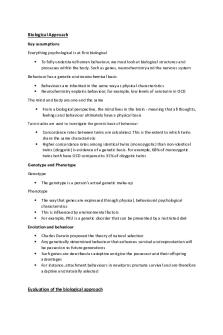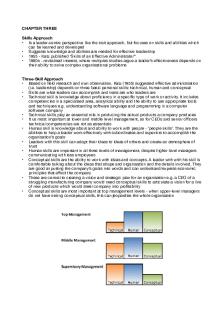Dramatistic Approach notes PDF

| Title | Dramatistic Approach notes |
|---|---|
| Course | Communication Criticism |
| Institution | Belmont University |
| Pages | 3 |
| File Size | 63.6 KB |
| File Type | |
| Total Downloads | 66 |
| Total Views | 132 |
Summary
Dramatistic Approach notes...
Description
Dramatistic Approach: ● Based on a philosophy from Shakesphere’s “all the world’s a stage”. Human behavior seen as a series of social dramas where humans are actors performing scripts on the public stage of their lives ● Creation of a rhetorical act is a choice or series of choices for which the rhetor must take responsibility ● Kenneth Burke’s theory of rhetoric 1. When people use language they’re acting in response to a situation. Humans are symbolusing creatures. Symbols allow us to say what is permitted and prohibited behavior. a. In this philosophy, the ability to symbolize verbally is the defining characteristic of humanity. ● In dramatism, the essence of being human is caught up in the tension between motion and action ○ Motion occurs in the natural realm of the physical world. Nature doesn’t use symbols to change the face of the world. ○ Action is the counterforce to motion in the substance of humanity. Nature moves; people act. People are a part of nature but they use action to overcome nature and respond to situations in the natural realm. Only action can create symbols (religion is made up of symbols). Symbols hold ○ The view of people as symbol-using shows that our behavior is primarily rhetorical. Action is language using. ● Burke shows a new way to view the function of rhetoric: identification Motive: ● Reality is constructed through symbol use. ● Symbols are used to name or label things, to characterize relationships and functions among things as friendly or unfriendly. Naming and labeling reveals the rhetor’s attitudes or motives. ● Motive: the combination of language use and action in a given situation. A critic determines the rhetor’s attitudes by examining the label symbols chosen for the rhetorical act. Rhetors don’t respond to situations in the ways they do without cause. The critic determines what constraints operated in the situation, and the concept of motive helps discover them. ● Rhetorical activity is not arbitrary. Rhetorical critics want to discover how and why symbols become meaningful in a situation and what impels a rhetor to choose one symbol or another. 2. Society is created and maintained through symbols, which are used to control behavior. a. Hierarchies-- Social relationships have structures that range from informal with loose structure to formal with rigid structure. Hierarchies in the social order are
structures that divide people into categories that are based on power. A person’s role in hierarchy is played through social manipulation. b. Acceptance and rejection-- hierarchies provide the stimulus of dramatic action. People have the ability to accept or reject the social order and their position in its hierarchy. Acceptance is a positive reaction to the hierarchy; rejection is a negative reaction. Rejection results in alienation or disorder. c. Guilt, purification and redemption-- in rhetorical criticism, the object of criticism often involves a rhetor’s advocacy of the supreme hierarchy over another. Rejecting a hierarchy produces a feeling of guilt. To resolve this guilt, there are 2 forms of ritual purification common in the social drama: i. Mortification: involves a personal sacrifice by the guilty. ii. Victimage: more often based on what dramas are based on; where a scapegoat is publicly saddled with the guilt. iii. The act of purification must be appropriate to the sin of the guilty for the drama to succeed as an act of redemption ● 2 additional concepts that help the critic to structure criticism: identification and pentad. ○ Identification: the concept used to find attitudes or motives that reveal what the drama is about. Rhetoric must be viewed as identification rather than persuasion because its function is to proclaim unity. In this approach, rhetoric is a symbolic means of creating cooperation. ○ Pentad: offers a system for describing these attitudes as they are articulated in the drama. ● Rhetorical strategies: any choice made by the rhetor that enables him to fulfill the need to respond to a specific constraint in the rhetorical situation. ○ Comprised of the entire stock of verbal behavior available to message makers: naming, argumentation, narration, definition, description, repetition, use of figurative language, patterns of organization, and any device of adornment ○ Strategies also include the role the rhetor plays relative to the audience: interpreter of meaning, exhorter for a cause, justifier of what was done, explainer of reality, etc. ● Ethical standard. The critic who chooses this approach must have a strong commitment to the ethical standard of judgement because the underlying assumption of Burke’s theory of rhetoric is that cooperation through identification is rhetoric’s function. Identification can be constructive as well as constructive, ● The truth standard: can be used in evaluating rhetorical acts from the perspective of the dramatistic approach. Identification can be viewed as the process a rhetor uses to create social truth. Identification can be used to judge the rhetor’s creation of reality in terms of how it compares with competing views. ● The aesthetic standard. The dramatistic approach gives the critic a vocabulary for studying the artistic uses of language. You can judge the function and effect of specific
linguistic strategies by evaluating how the metaphor functions in the rhetor’s attempt to create identification. ● The results standard. Dramatism enables you to assess results by determining whether or not the rhetor achieved identification
● Unite people to induce cooperation ● Using symbols to try to get recognition from the people you're talking to. A mode of persuasion ● Symbols rely on context ● Symbols represent a common interest...
Similar Free PDFs

Dramatistic Approach notes
- 3 Pages

Social Approach - Notes
- 4 Pages

Brunnstrom Approach NOTES
- 9 Pages

Literal Approach
- 3 Pages

Interactionist Approach
- 1 Pages

Literal Approach
- 2 Pages

Biological approach
- 2 Pages

Psychodynamic Approach
- 2 Pages

Reading Materials (Fuller Approach)
- 20 Pages

Lecture 2 - Skills Approach
- 3 Pages

The cognitive approach
- 1 Pages

A - LINGUISTIC APPROACH
- 2 Pages
Popular Institutions
- Tinajero National High School - Annex
- Politeknik Caltex Riau
- Yokohama City University
- SGT University
- University of Al-Qadisiyah
- Divine Word College of Vigan
- Techniek College Rotterdam
- Universidade de Santiago
- Universiti Teknologi MARA Cawangan Johor Kampus Pasir Gudang
- Poltekkes Kemenkes Yogyakarta
- Baguio City National High School
- Colegio san marcos
- preparatoria uno
- Centro de Bachillerato Tecnológico Industrial y de Servicios No. 107
- Dalian Maritime University
- Quang Trung Secondary School
- Colegio Tecnológico en Informática
- Corporación Regional de Educación Superior
- Grupo CEDVA
- Dar Al Uloom University
- Centro de Estudios Preuniversitarios de la Universidad Nacional de Ingeniería
- 上智大学
- Aakash International School, Nuna Majara
- San Felipe Neri Catholic School
- Kang Chiao International School - New Taipei City
- Misamis Occidental National High School
- Institución Educativa Escuela Normal Juan Ladrilleros
- Kolehiyo ng Pantukan
- Batanes State College
- Instituto Continental
- Sekolah Menengah Kejuruan Kesehatan Kaltara (Tarakan)
- Colegio de La Inmaculada Concepcion - Cebu



